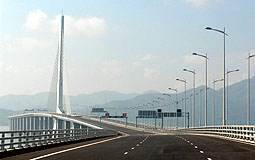
|
| New landmark: Shenzhen Bay Bridge, with its single inclined tower cable-stayed bridges and viaducts, will become a prominent Deep Bay landmark. |
The commissioning of Shenzhen Bay Bridge on July 1 will mark a new era for closer economic and social ties between Hong Kong and the Mainland, Secretary for the Environment, Transport & Works Dr Sarah Liao says.
The bridge will provide a timely solution to increasing cross-boundary traffic. During the initial opening period, its two-way daily flow will be about 29,800 vehicles and 30,800 passengers. This will rise to 60,300 vehicles and 61,300 passengers a day in 2016.
The bridge starts from new reclamation in Dongjaotou in Shekou, where the boundary crossing facilities are located, stretches across Deep Bay, lands in north-western New Territories at Ngau Hom Shek, and connects to Yuen Long Highway.
Convenient services
The co-location arrangement to be adopted at Shenzhen Bay Port, the first of its kind to be implemented at control points, will provide convenient and efficient services to passengers and vehicles in a better environment.
"This new cross-boundary link is expected to bring a net economic benefit of $175 billion over the 20-year planning horizon from 2000 to 2020. By alleviating traffic pressure particularly at the three nearly saturated existing vehicular boundary crossings at Lok Ma Chau, Man Kam To and Sha Tau Kok, it will boost further economic development, in the areas of finance, logistics and tourism," Dr Liao said.
The 5.5km-long bridge is in the form of elevated viaducts and cable-stayed bridges. The Hong Kong section runs for 3.5km and was constructed by Hong Kong at a project cost of $3.2 billion. The remaining 2km of the bridge was built by the Shenzhen Municipal People's Government.
Close co-operation
Dr Liao said the design of Shenzhen Bay Bridge demonstrated the close co-operation between the two sides.
"The design concept has been worked out between Hong Kong and Shenzhen authorities. The towers of the two cable-stayed bridges are inclined towards each other, pulling their approach viaducts towards the boundary. It symbolises the wish of people in the two regions to build a synergistic relationship to greater prosperity. The bridge with its single inclined tower cable-stayed bridges and viaducts will become a prominent landmark at Deep Bay," she said.
The efficient completion of Shenzhen Bay Bridge and Shenzhen Bay Port demonstrates the professionalism and close co-ordination of government bureaux and departments. Construction started in August 2003, and the deck structures of the Shenzhen and Hong Kong sections were connected in January last year.
Spectacular bridge
"All colleagues involved in this project have devoted their effort in bringing this spectacular bridge and the innovative concept of co-location from the drawing board to fruition within a very short time," Dr Liao said.
Despite the fact that construction was conducted at full speed, the Government spared no effort in protecting the environment, particularly in Deep Bay, which is an area of high ecological value. Starting as early as the planning stage, extensive consultations with green groups were conducted and their views were taken into account.
The main contractor implemented all mitigation measures listed in the environmental permit to protect the area. To enable the transportation of construction materials over mudflats without polluting the area, a 1.8km long, nine-metre wide temporary steel bridge, the largest of its kind in Hong Kong, was built.
"Environmentally-friendly measures were put in place during construction to protect water quality, including constructing bridge piers inside cofferdams, using closed grab dredgers and deploying silt curtains to prevent the escape of sediment during dredging," Dr Liao said.
Long-term benefits
The bridge project has brought long-term benefits to Deep Bay's ecosystem. A water channel connecting shrimp ponds at the Mai Po Ramsar Site to Deep Bay has been desilted to improve the water exchange rate to the ponds and enhance the feeding ground for birds.
"The construction of the Shenzhen Bay Bridge has proved that natural environment can be preserved when comprehensive mitigation measures, coupled with good design and site practices, are implemented," Dr Liao said.
With the commissioning of the bridge, the Customs & Excise, Police, Immigration, Highways and Transport Departments will continue their collaboration to ensure smooth traffic and passenger flow.
|